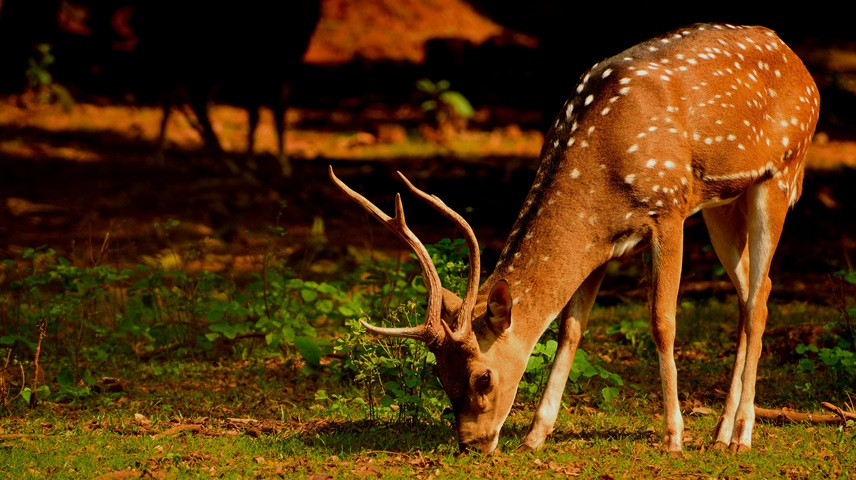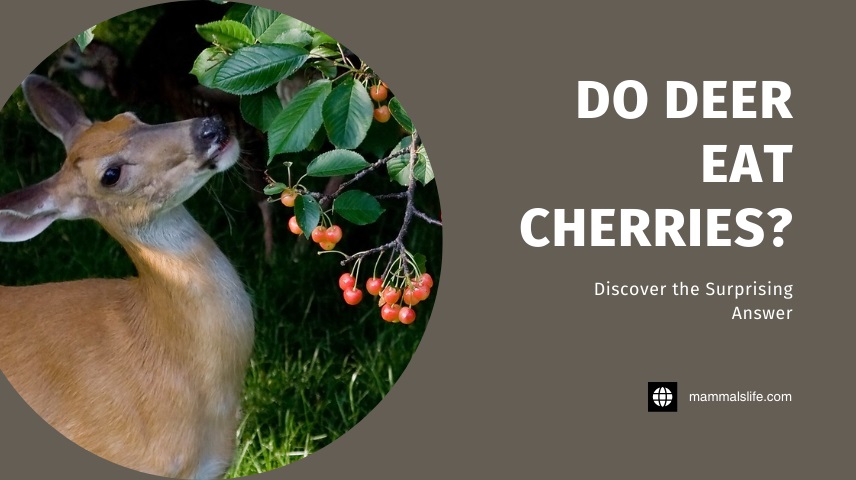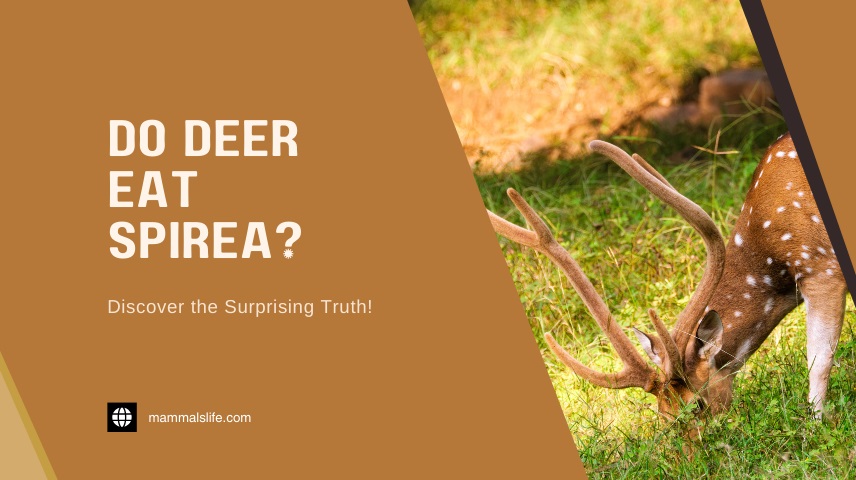Last Updated on February 22, 2025 by Mammals Life
Gardening can be a peaceful and rewarding activity, but it often comes with the challenge of managing wildlife, particularly deer. These graceful yet destructive creatures can wreak havoc on gardens, munching on everything from flowers to vegetables. Understanding which plants are at risk is crucial for gardeners who want to protect their hard work. We will delve into whether deer eat potato plants, why they might do so, and explore strategies to safeguard your crops from these hungry visitors.
First Need to Know Deer Behavior and Diet
Deer Eating Habits
Deer are herbivores with a varied diet, primarily consisting of leaves, twigs, fruits, and various plants. Their eating habits are highly influenced by the availability of food, which can change with the seasons. During spring and summer, when vegetation is abundant, deer tend to browse various plants. However, when food becomes scarce in fall and winter, deer are less selective and may eat plants they would typically avoid.
Do Deer Eat Potato Plants?
Potato plants are not typically at the top of a deer’s preferred menu, but they are not entirely immune to being eaten. Deer are known to nibble on the tender leaves and stems of potato plants, especially if they are hungry and alternative food sources are limited. While potatoes themselves are underground and safe from deer, the foliage is vulnerable. Some gardeners report that deer have caused significant damage to their potato crops, particularly during dry spells or in regions with high deer populations.
Read More – Do Deer Eat Potatoes? Understanding the Dietary Habits of Deer
The Impact of Deer on Potato Plants
Damage Caused by Deer
Deer can cause various types of damage to potato plants. The most common signs include bite marks on the leaves, broken stems, and trampled foliage. This damage can significantly impact the health and yield of the plants. In severe cases, a deer attack can lead to stunted growth or even the complete loss of the crop. The extent of the damage often depends on the size of the deer population and the level of hunger they are experiencing.
Why Deer Might Target Potato Plants
There are several reasons why deer might choose to munch on potato plants. The tender leaves and stems of potato plants are relatively easy for deer to eat, especially when other food sources are scarce. Additionally, potato plants may be more vulnerable if they are located in an area where deer are already accustomed to feeding. The nutritional content of the foliage can also play a role, as deer might be attracted to the moisture and nutrients that potato plants provide.
Read More – Do Deer Eat Sweet Potatoes? Insights from Wildlife Experts
Preventing Deer from Eating Potato Plants
Fencing and Physical Barriers
One of the most effective ways to protect potato plants from deer is to install fencing. A fence that is at least 8 feet high is recommended, as deer are excellent jumpers and can easily clear lower barriers. The fence should be made of sturdy materials, such as wire mesh or wood, to prevent deer from pushing through or under it. If a full fence is not feasible, consider using row covers or netting to create a physical barrier around the plants.
Natural Deterrents
Natural repellents can be a useful addition to your deer management strategy. Certain plants, such as lavender, marigolds, and garlic, are known to repel deer due to their strong scents. You can plant these around the perimeter of your potato patch as a natural deterrent. Homemade sprays made from ingredients like hot peppers, garlic, or eggs can also be effective when applied to the foliage. Commercial products are available as well, offering a convenient solution for those who prefer ready-made options.
Electronic Deterrents
Electronic deterrents can add an extra layer of protection for your garden. Motion-activated sprinklers are a popular choice, as they deliver a sudden burst of water when deer approach, scaring them away without causing harm. Similarly, motion-activated lights or noise devices can startle deer and discourage them from entering your garden. These electronic tools can be particularly effective when used in combination with other deterrents.
Companion Planting
Companion planting involves growing certain plants together to enhance growth, deter pests, or attract beneficial insects. In the case of deer, planting species they dislike alongside your potato plants can help keep them at bay. Plants like rosemary, sage, and mint are often avoided by deer due to their strong scents and flavors. By surrounding your potato plants with these natural repellents, you can create a less inviting environment for deer.
Alternative Strategies for Deer Management
Creating a Deer-Resistant Garden
To minimize the risk of deer damage, consider designing a deer-resistant garden. This involves selecting plants that are less likely to be eaten by deer, such as those with tough, spiny, or aromatic foliage. While potato plants may not be completely deer-resistant, incorporating other deer-resistant species into your garden can reduce the overall appeal to deer and help protect your more vulnerable crops.
Understanding Local Deer Populations
Knowing the habits and movements of the deer in your area can be invaluable for managing their impact on your garden. Deer tend to follow specific routes and patterns, often returning to the same feeding grounds. By observing these patterns, you can identify the best locations for deterrents and barriers. Collaborating with neighbors or local wildlife agencies can also help in developing a community-wide approach to deer management, reducing the overall pressure on your garden.
Legal and Ethical Considerations
It’s important to be aware of local regulations regarding deer management, as there are often laws governing the use of certain deterrents or barriers. In some areas, relocating or harming deer may be illegal. Always consider ethical approaches that prioritize the humane treatment of wildlife, such as using non-lethal deterrents and encouraging natural predators.
What to Do If Deer Have Already Damaged Your Potato Plants
Assessing the Damage
If deer have already damaged your potato plants, the first step is to assess the extent of the damage. Check for broken stems, missing foliage, and signs of trampling. Determine whether the plants are likely to recover or if replanting is necessary. In many cases, potato plants can bounce back if the damage is not too severe, especially if the root system is intact.
Immediate Actions
To prevent further damage, take immediate action by installing temporary barriers, such as netting or stakes, around the affected plants. Applying a strong-smelling repellent spray can also help deter deer from returning. It’s crucial to act quickly, as deer are likely to revisit a site once they know it contains food.
Long-Term Recovery Strategies
Helping your potato plants recover from deer damage involves providing them with extra care and nutrients. Prune any damaged foliage to encourage new growth, and consider applying a balanced fertilizer to boost their recovery. Keep the plants well-watered, as stress from drought can exacerbate the damage caused by deer. With proper care, many potato plants can recover and continue to produce a healthy crop.
FAQs
Do deer commonly eat potato plants?
While deer do not specifically seek out potato plants, they may eat the foliage if other food sources are scarce. The underground potatoes themselves are typically safe, but the leaves and stems are vulnerable, especially during periods of drought or when deer populations are high.
What are the best ways to prevent deer from eating potato plants?
The most effective method is installing a high fence around your garden. You can also use natural repellents like garlic spray, companion planting with deer-resistant herbs, and electronic deterrents such as motion-activated sprinklers to keep deer away from your potato plants.
Can potato plants recover from deer damage?
Yes, potato plants can often recover from deer damage, especially if the root system is intact and the damage is limited to the foliage. Pruning damaged parts, applying fertilizer, and ensuring proper watering can help the plants recover and continue growing.
Are there plants I can grow alongside potatoes to deter deer?
Yes, planting deer-resistant herbs and flowers such as rosemary, sage, lavender, and marigolds around your potato plants can help deter deer. These plants have strong scents that deer typically avoid, making your garden less attractive to them.
What should I do if deer have already damaged my potato plants?
If you notice deer damage, immediately install temporary barriers like netting to prevent further harm. Prune any broken or damaged foliage and apply a repellent spray. With proper care, including extra watering and fertilization, your potato plants may recover and continue to produce a healthy crop.
Conclusion
Managing wildlife, particularly deer, is an essential aspect of successful gardening. While deer may occasionally eat potato plants, there are numerous strategies you can employ to protect your crops. From fencing and natural repellents to companion planting and electronic deterrents, the options are diverse and can be tailored to suit your specific needs. By understanding deer behavior and taking proactive measures, you can enjoy a bountiful potato harvest without the worry of deer damage. Remember, a well-protected garden is not only a joy to tend but also a testament to your dedication as a gardener.
Encourage your fellow gardeners to share their experiences and tips on managing deer in the comments section. Together, we can cultivate gardens that thrive, even in the face of wildlife challenges.











